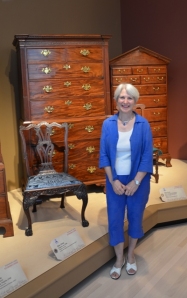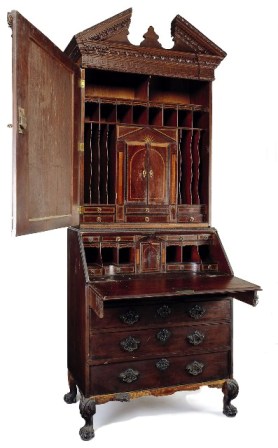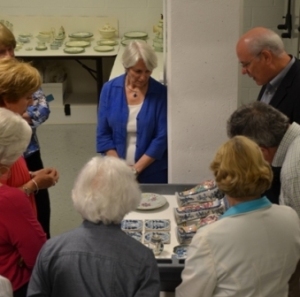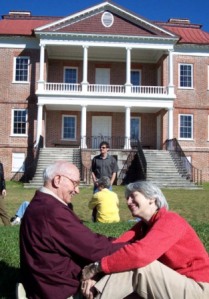Voted the Best Place to See by Condé Nast Traveler.

by Anne Drayton Nelson
Last June I had a wonderful opportunity to see a preview of the upcoming Exhibit entitled A Rich and Varied Culture: The Material World of the Early South that will open officially at Colonial Williamsburg’s DeWitt Wallace Decorative Arts Museum on February 15, 2014. This Drayton Hall-sponsored trip included staff, Drayton family members, current and former advisory site council members, and other sincerely interested individuals.

The Drayton Hall group at the preview; the author, in blue, stands next to the newly conserved Bureau Bookcase.

The author at the behind-the-scenes preview; on the left, a newly conserved mahogany side chair that once graced Drayton Hall’s great hall.
We had a lovely gathering the night before the private tour, and the day of the tour we were greeted and led by the expert curators at Colonial Williamsburg, including Ron Hurst and Margaret Pritchard. The exhibit has been in the works for several years and covers all aspects of the decorative arts in the early South. We were given behind-the-scenes views of the various departments of restoration, including furniture, paper, art, and upholstery, and shown Colonial Williamsburg’s extensive collection. It was absolutely fascinating to see pieces of furniture in varying stages of restoration, and absolutely astounding to learn of the research applied before any restoration was begun. The curators are incredibly knowledgeable and shared their expertise with enthusiasm and pleasure. It was a most exciting and rewarding experience.
Being a member of the Drayton family, it was especially exciting and rewarding to see pieces that I had known as a child brought back to such vibrant life! The secretary desk, as we called it (now referred to as the “bureau bookcase”), had made a remarkable resurrection. I remembered it as dark, dull, and missing some trim. It is now literally glowing with health and all its wounds repaired and invisible! I also remembered one of its secret compartments, which I remembered only as that—a secret compartment. With the research and restoration, the “prospect”—its formal name—now shows its stunning craftsmanship and wood-carving artistry. The compartment’s “floor” inlay reveals a beautiful star pattern and its mirrored back reflects light onto it. It has become a miniature “ballroom” for storing secret treasures.

The early 18th-century bureau bookcase before conservation. See its remarkable “resurrection” at Colonial Williamsburg with the opening of the exhibit in February 2014.
Seeing another piece of Drayton family furniture, the 18th-century clothespress, in the process of being restored was also exciting. I had remembered it as beautiful, but what it has become in its restoration is stunning.

Viewing a selection of newly conserved Drayton porcelain objects that will in included in the exhibit.
Among the other Drayton family pieces that are to be a part of the exhibit, it was uplifting to see the restoration of a 1736 George Edwards watercolor as well as the minute and tedious work of restoring an early architectural rendering of Drayton Hall, which emphasizes the Palladian concept and design. The 1736 telescope that had belonged to builder John Drayton was magnificent with its cleaned and polished brass. It was also moving to see some porcelain pieces that had been in my parents’ home and some that had even been in my own. To have these family heirlooms understood, appreciated, and treasured warms my heart, and having them shared with a wider audience makes me very proud.
I am grateful to the partnership between Drayton Hall and Colonial Williamsburg because it elevates the outreach of both organizations. Each organization has outstanding personnel and when working together they extend the expertise of each. I urge anyone who has the opportunity to attend the DeWitt Wallace exhibit A Rich and Varied Culture: The Material World of the Early South, to do so, as it is a unique and outstanding collection and presentation of treasures from across the early South.
 Anne Drayton Nelson is an eighth generation Drayton family descendant who has fond childhood memories of climbing the ancient live oak trees at Drayton Hall. Shown here with her father Charles Henry “Charlie” Drayton, III, at a Thanksgiving gathering at Drayton Hall—an annual tradition for the Drayton family and relatives. The National Trust for Historic Preservation acquired Drayton Hall from Charlie and his late brother, Frank, in 1974, in order to protect and preserve this icon of colonial American architecture.
Anne Drayton Nelson is an eighth generation Drayton family descendant who has fond childhood memories of climbing the ancient live oak trees at Drayton Hall. Shown here with her father Charles Henry “Charlie” Drayton, III, at a Thanksgiving gathering at Drayton Hall—an annual tradition for the Drayton family and relatives. The National Trust for Historic Preservation acquired Drayton Hall from Charlie and his late brother, Frank, in 1974, in order to protect and preserve this icon of colonial American architecture.